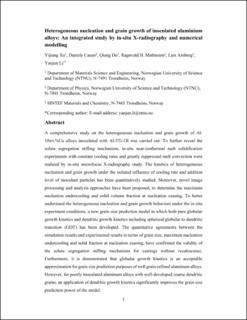| dc.contributor.author | Xu, Yijiang | |
| dc.contributor.author | Casari, Daniele | |
| dc.contributor.author | Du, Qiang | |
| dc.contributor.author | Mathiesen, Ragnvald | |
| dc.contributor.author | Arnberg, Lars | |
| dc.contributor.author | Li, Yanjun | |
| dc.date.accessioned | 2020-12-16T12:01:57Z | |
| dc.date.available | 2020-12-16T12:01:57Z | |
| dc.date.created | 2017-10-31T10:23:52Z | |
| dc.date.issued | 2017 | |
| dc.identifier.citation | Acta Materialia. 2017, 140 224-239. | en_US |
| dc.identifier.issn | 1359-6454 | |
| dc.identifier.uri | https://hdl.handle.net/11250/2719806 | |
| dc.description.abstract | A comprehensive study on the heterogeneous nucleation and grain growth of Al-10 wt.%Cu alloys inoculated with Al-5Ti-1B was carried out. To further reveal the solute segregation stifling mechanism, in-situ near-isothermal melt solidification experiments with constant cooling rates and greatly suppressed melt convection were realized by in-situ microfocus X-radiography study. The kinetics of heterogeneous nucleation and grain growth under the isolated influence of cooling rate and addition level of inoculant particles has been quantitatively studied. Moreover, novel image processing and analysis approaches have been proposed, to determine the maximum nucleation undercooling and solid volume fraction at nucleation ceasing. To better understand the heterogeneous nucleation and grain growth behaviors under the in-situ experiment conditions, a new grain size prediction model in which both pure globular growth kinetics and dendritic growth kinetics including spherical/globular to dendritic transition (GDT) has been developed. The quantitative agreements between the simulation results and experimental results in terms of grain size, maximum nucleation undercooling and solid fraction at nucleation ceasing, have confirmed the validity of the solute segregation stifling mechanism for castings without recalescence. Furthermore, it is demonstrated that globular growth kinetics is an acceptable approximation for grain size prediction purposes of well grain-refined aluminum alloys. However, for poorly inoculated aluminum alloys with well-developed coarse dendritic grains, an application of dendritic growth kinetics significantly improves the grain size prediction power of the model. | en_US |
| dc.language.iso | eng | en_US |
| dc.publisher | Elsevier | en_US |
| dc.rights | Attribution-NonCommercial-NoDerivatives 4.0 Internasjonal | * |
| dc.rights.uri | http://creativecommons.org/licenses/by-nc-nd/4.0/deed.no | * |
| dc.subject | Solute segregation | en_US |
| dc.subject | Solidification | en_US |
| dc.subject | Grain refinement | en_US |
| dc.subject | Grain growth | en_US |
| dc.subject | Heterogeneous nucleation | en_US |
| dc.title | Heterogeneous nucleation and grain growth of inoculated aluminium alloys: An integrated study by in-situ X-radiography and numerical modelling | en_US |
| dc.type | Peer reviewed | en_US |
| dc.type | Journal article | en_US |
| dc.description.version | acceptedVersion | en_US |
| dc.rights.holder | © 2017. This is the authors’ accepted and refereed manuscript to the article. This manuscript version is made available under the CC-BY-NC-ND 4.0 license http://creativecommons.org/licenses/by-nc-nd/4.0/ | en_US |
| dc.source.pagenumber | 224-239 | en_US |
| dc.source.volume | 140 | en_US |
| dc.source.journal | Acta Materialia | en_US |
| dc.identifier.doi | 10.1016/j.actamat.2017.08.053 | |
| dc.identifier.cristin | 1509189 | |
| cristin.unitcode | 7401,80,4,3 | |
| cristin.unitname | Støping, forming og resirkulering | |
| cristin.ispublished | true | |
| cristin.fulltext | preprint | |
| cristin.fulltext | original | |
| cristin.qualitycode | 2 | |

